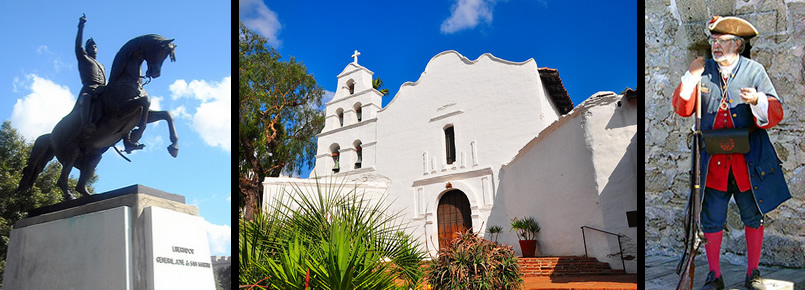

American Latino Heritage
San Estevan del Rey Mission Church
New Mexico
 |
San Estevan Del Rey Mission Church |
For more than two centuries of colonization, Spanish missions in New Mexico, backed by the power of the Spanish military, imposed European culture and Christian beliefs on the Pueblo, Zuni, and Hopi groups throughout the territory. At Acoma Pueblo, Friar Juan Ramirez founded the San Estevan del Rey Mission in 1629 after a period of violence between the Spanish and Acoma. The friars worked to replace Acoma beliefs with those of Christianity and banned practices they believed were immoral or blasphemous. The Spanish also introduced the Acoma to animal husbandry and European methods of farming. Some Acoma assimilated, some accommodated, and some waited for an opportunity to drive out the Spanish.
In 1680, Pueblo leader Popé led a successful indigenous rebellion in villages across New Mexico and removed the Spanish colonists from the region. Called the Pueblo Revolt, this organized uprising was the result of decades of mistreatment and suppression of indigenous culture by the secular and religious Spanish administrators. At Acoma Pueblo, rebels killed the resident priest. Though Spain officially resettled in New Mexico in 1692, it was seven more years until the Spanish took Acoma Pueblo. Don Diego de Vargas led an attack on the pueblo in 1696, but failed.
Prior to the construction of a road to the pueblo, the village was accessible only by climbing the steep stone steps cut into narrow passages through the rocky mesa. Limited accessibility made the village nearly impregnable, and the Acoma did not surrender the village to the Spanish until 1699. Despite Pueblo attempts to wipe out evidence of Catholicism in New Mexico during the Revolt, the San Estevan del Rey Mission Church survived and mission life resumed after Spain took control of the village. In the 19th century, three countries – Spain, Mexico, and the United States -- consecutively claimed New Mexico. Acoma Pueblo accommodated the new cultures and governments of Mexico and the United States.
 |
View of Acoma Pueblo and Sky City |
Construction of the Acoma Pueblo mission church was a 12-year project, begun shortly after the Spanish founded the mission in 1629 and completed in 1642. During these years, much of the adobe village was built too. The church is 150 feet long and 40 feet at its widest, constructed of the same adobe bricks and plaster used to build the older village structures. The roof is adobe with wooden beams called “vigas.” The vigas are over 40 feet long and 14 inches square. The timber necessary to craft them was transported 30 miles from the San Mateo Mountains, probably carried by Acoma on foot. The adobe walls of the mission church are over seven feet thick on one side of the church and almost five on the opposite side. A parapet surrounds the roof and twin towers with belfries that face east.
The whitewashed interior of the mission church is sparsely decorated. Above the church entrance is the choir loft. On the opposite end is the altar that is decorated by a simple reredos in Catholic and Acoma design. North of the church is the one-story convento, where the friars lived during the colonial period. In front of the church is the historic cemetery, which is made of soil carried to the top of the stone mesa. Acoma men, women, and children, whose labor the Franciscans directed, built the church.
Today, San Estevan del Rey Mission Church and Acoma Pueblo are on the Acoma Indian Reservation in Acoma, New Mexico. Access to the top of the mesa is no longer limited to the difficult stone steps. The community is reachable by vehicle. The Acoma Tribal Council and Tribal Administration give guided tours of the Acoma Pueblo and church. Within the well-preserved pueblo village, visitors can learn more about Acoma history and culture at the Haak'u Museum.
| Plan your visit |
San Estevan del Rey Mission Church, a National Historic Landmark, is located south of Interstate 40 on State Route 23 at Acoma Pueblo, NM. Guided tours of the mission church and Acoma Pueblo are available for a fee. Photography of the pueblo is allowed with a permit, but visitors are asked not to photograph the cemetery and interior of the Mission Church. For more information, visit the Acoma Sky City website or call 505-470-4966 or 800-747-0181. San Estevan del Rey Mission Church has been documented by the National Park Service’s Historic American Buildings Survey. Acoma Pueblo and is also featured in the National Park Service American Southwest Travel Itinerary. |